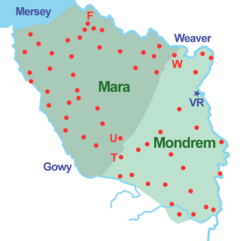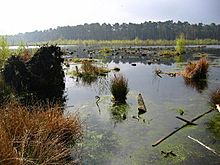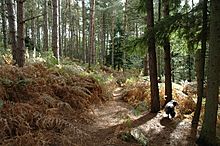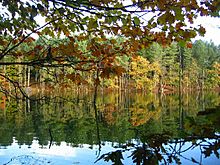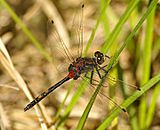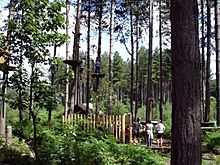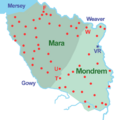Delamere Forest facts for kids
Quick facts for kids Delamere Forest Park |
|
|---|---|
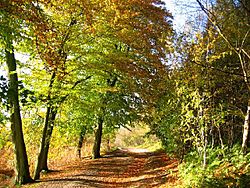
Deciduous woodland at Delamere Forest in Autumn
|
|
| Lua error in Module:Location_map at line 420: attempt to index field 'wikibase' (a nil value). | |
| Type | Forest park |
| Location | Cheshire |
| OS grid | SJ547704 |
| Area | 972 hectares (2,400 acres) |
| Elevation | c.75–175 metres (246–574 ft) |
| Operated by | Forestry England |
| Open | 8am–8pm (visitor centre) |
| Parking | Six on-site car parks |
| Public transit access | Delamere railway station |
| Website | http://www.forestryengland.uk/delamere-forest |
Delamere Forest is a huge forest in the village of Delamere in Cheshire, England. This forest is looked after by Forestry England. It covers about 972 hectares (2,400 acres), making it the biggest forest area in Cheshire. You'll find a mix of trees here: some that lose their leaves in autumn (called deciduous) and others that stay green all year (called evergreen).
Its name, Delamere, means "forest of the lakes." It's what's left of two huge old forests called Mara and Mondrem. These forests once covered over 60 square miles (160 km2) of Cheshire. They were set up in the late 1000s for the Norman Earls of Chester to hunt in. Special rules, called forest law, controlled the area. These rules made it hard for people to farm the land for many years.
In 1812, the forest became property of the King, and the old rules were stopped. Then, in 1924, the Forestry Commission started looking after the woodland.
The forest also has a tall hill called Old Pale. This is the highest point in the northern part of the Mid Cheshire Ridge. There's also a lake called Blakemere Moss, which is about 1 kilometre (0.62 mi) long. Black Lake is a special place with a rare type of bog. It's so important that it's a Site of Special Scientific Interest (SSSI) and part of an international wetland site. Linmer Moss is another SSSI because of its unique fen habitat. Rare plants like marsh fern and white sedge grow here. You might even spot the white-faced darter, a type of dragonfly that's very rare in the UK.
Delamere Forest is a popular spot for fun activities. Around 750,000 people visit each year! They come for walks, bike rides, mountain biking, and horse riding. It's also a place where outdoor concerts are held.
Contents
History of Delamere Forest
Ancient Hunting Grounds
The twin medieval forests of Mara and Mondrem were created in Cheshire by the Norman Earls of Chester in the late 1000s. Some people think it might have been an Anglo-Saxon hunting forest even before that.
These forests were huge, covering more than 60 square miles (160 km2). They stretched from the Mersey River in the north to Nantwich in the south. From the Gowy River in the west to the Weaver River in the east. Between 1277 and 1536, over 60 villages were inside these forests. When we say "forest" here, it means an area with special rules, not just a place full of trees. The land was still mostly owned by private people.
Hunters used dogs to chase animals like wild boar, red deer, fallow deer, and roe deer. In the early Norman times, if you killed game without permission, you could be blinded or even executed. But over time, these harsh punishments were replaced with fines.
The original forest was mostly oak trees mixed with others. You could also find elm, lime, yew, chestnut, ash, silver birch, hazel, willow, and alder. The forest also had open heathland, wetland, pastures, and even small farms. But farming was only allowed with strict limits. Clearing new land for farming was not allowed until 1215.
Over time, large parts of the Mondrem forest were cleared. But the northern part, the Forest of Mara, stayed wooded well into the 1300s. It was still home to wild boar and wolves.
Later Years of the Forest
The remaining part of the Forest of Mara was still considered a hunting forest until 1812. That year, a new law changed its status back to regular land. Half of it went to the King, and the other half to big landowners nearby.
The Forestry Commission started managing Delamere Forest in 1924. They focused on growing trees for timber. Since 1968, the Forestry Commission has also worked with local councils to encourage people to visit and enjoy the area.
Blakemere Moss Lake
Blakemere Moss was drained around 1815. Some say prisoners from the Napoleonic Wars did the work. In the 1800s, people tried to plant oak trees there, but it didn't work. Later, they tried Scots pine. In the 1940s, the Forestry Commission planted pine and western hemlock, but this also wasn't successful.
In 1996, experts checked if it was possible to bring the water back to Blakemere Moss. When they found it was, the trees were cut down in 1998. The area was then re-watered by blocking the drainage points. Now, the restored moss is a home for many different animals, especially waterfowl. Because this project was so successful, in 2010, they decided to re-water more drained wetland areas in Delamere Forest.
Forest Landscape and Nature
Delamere Forest is part of the Mersey Forest project. This project aims to plant more trees near towns and cities. Most of the land managed by the Forestry Commission is open for everyone to explore.
The Mid-Cheshire Railway Line runs through Delamere Forest. Delamere railway station is about half a mile (800 meters) from the Linmere Visitor Centre. Roads like the B5152 and Ashton Road also cross the forest. The National Cycle Network (Regional Route 70) follows Ashton Road, making it great for bikes. Nearby towns and villages include Frodsham, Delamere, Cuddington, Norley, Kingsley, Mouldsworth, and Kelsall.
Mouldsworth Gap Area
Most of Delamere Forest sits in a place called the Mouldsworth Gap. This is a break in the Mid Cheshire Ridge, a line of hills running through Cheshire. This area was formed at the end of the last ice age. Melting ice created a huge lake that burst through the sandstone hills. This left behind lots of sand and gravel. The soils here are very mixed, including different types of earth and peat. One small valley even has eight different soil types!
This part of Delamere Forest has rolling hills, mostly between 60 and 90 meters high. It has many small hills and peatland basins. Some of these were formed by glaciers, while others were created when sand was dug out. These basins now hold lakes and bogs (called mosses) within the forest. Blakemere Moss is the largest, about 1 km long. Other wetlands include Black Lake, Dead Lake, and Linmer Moss. The forest also has named hills like Hart Hill, Hunger Hill, and Manley Hill.
Old Pale Hill Views
The Old Pale hill is about 176 meters high. It's the highest point in the northern part of the Mid Cheshire Ridge. At the very top, called Pale Heights, there's a trig point (a survey marker) and three tall masts for radio, TV, and phone signals. From here, you can see amazing views of twelve different counties and areas! These include Cheshire, Cumbria, Derbyshire, Greater Manchester, Lancashire, Merseyside, Shropshire, and Staffordshire in England. In Wales, you can see Conwy, Denbighshire, Flintshire, Powys, and Wrexham.
Wildlife and Special Habitats
Delamere Forest has many different types of habitats. You'll find broadleaved woodlands (trees that lose leaves), coniferous plantations (evergreen trees), grasslands, and wetlands. This variety means lots of different animals and plants can live here.
Many woodland birds call Delamere home. These include nuthatches, treecreepers, common crossbills, Eurasian siskins, tawny owls, and great spotted and green woodpeckers. In the wet areas, you might see dragonflyes like the southern hawker. The white-faced darter, a very rare dragonfly in the UK, has been seen at places like Black Lake. Butterflies like the small tortoiseshell are common around Old Pale hill. You might also spot adders (a type of snake), badgers, foxes, and bats in the forest.
Special Protected Areas
Two Sites of Special Scientific Interest (SSSIs) are found within Delamere Forest. These are areas protected for their special nature.
Black Lake is a rare example of a "quaking bog" or schwingmoor. This is a type of bog where the plants form a mat that floats on top of the water. It's special because you can see all stages of this bog forming, from open water to more solid ground. Besides different types of moss, you'll find common sundew and the rare white sedge here. The Cheshire Wildlife Trust looks after this site. It's also part of a bigger international wetland area.
Linmer Moss is another SSSI. It's a fen environment, which is different from a bog. Here, the plants are mostly tussock sedge and reedmace. Rare plants like marsh fern and white sedge grow here. Other plants include cuckooflower, marsh bedstraw, and marsh cinquefoil. This site has had big changes in water levels over time. You can even see old birch tree trunks that died when the area flooded. Now, alder and willow trees are starting to grow there.
Other important wetland SSSIs are also found near Delamere Forest. These include Hatch Mere and Flaxmere Moss, which are just outside the main forest area. Also, Abbotts Moss, Oak Mere, and Pettypool Brook Valley. Some areas like Little Budworth Common SSSI and the woodland around Abbotts Moss are thought to be similar to how the forest looked before people settled there.
Fun Things to Do
Delamere Forest is a very popular place for recreation. Many visitors come from nearby towns and cities.
Three long-distance walking paths go through the forest: the Sandstone Trail, Delamere Way, and Baker Way. There are also two marked circular walking trails (1.7 and 2.7 miles (2.7 and 4.3 km)) and two marked cycling trails (4 and 7 miles (6.4 and 11.3 km)) that start near the Linmere Visitor Centre. The cycling trails are also open for walkers. For people using wheelchairs or pushchairs, there are two easy-access circular trails. One goes to Blakemere Moss (0.75 miles (1.2 km) long), and the other explores Old Pale hill. Many other unmarked paths are available for both cyclists and walkers. If you love mountain biking, there's a large area with dirt jumps on Manley Hill.
Other activities include horse riding, jogging, orienteering (a sport using maps and compasses), bird watching, and studying nature. Britain's biggest Go Ape adventure course opened in Delamere Forest in 2006. It has zip wires, Tarzan swings, tightropes, and nets high up in the trees! Delamere Forest also hosts the northern Hellrunner cross-country race, and the Sandstone Trail Race finishes here. A parkrun (a free, weekly 5k run) happens every Saturday on a loop around Blakemere Moss.
Since 2003, the Old Pale area of the forest has been a music venue. Famous performers like Ian Brown, The Charlatans, Jools Holland, Status Quo, Sugababes, Paul Weller, The Zutons, Tears for Fears, Doves, and Elbow have played concerts here. The forest has also been used for outdoor theatre shows.
The Linmere Visitor Centre has a covered picnic area, a café, and toilets (including ones for disabled visitors). You can also hire bikes and buy things at the shop. There are picnic spots all over the forest, especially near most car parks. During busy times, you can buy refreshments at the Barnsbridge and Whitefield car parks on weekends. A classroom and "learning garden" near the visitor centre can be rented for school trips or educational visits.
See also
- List of Sites of Special Scientific Interest in Cheshire
- List of parks and open spaces in Cheshire
Images for kids


